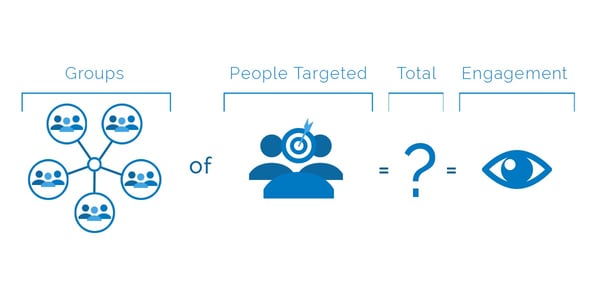Mobile Game Marketing: What You Need to Know to Begin
by Game Marketing Genie, on 03-Jul-2018 15:23:45
So, you’ve done the hard yards and developed a fun, great-looking game with plenty of depth and a rich user experience. Now all you have to do is release it and watch the accolades and revenue flow in, right?
Wrong.
If only it were that easy. This is the mentality that a lot of game industry veterans have, including those with a few decades of experience. In reality, that’s not surprising. The same thought process exists in commercial music and movie studios, and many of those have been around for almost a century or more now.
The reality is, a great game alone won’t cut it. The odds of “hitting it big” just by having a great game and releasing it into the wild are kind of like buying a lottery ticket – huge reward, but a very low likelihood of winning. Now, what if we told you there was a way to drastically improve your chances of winning that lottery?
A stacked deck
Like the logic of lotteries - extremely low chance of winning, extremely high reward - your mobile game needs a little bit more to make it. There are hundreds of thousands of developers spread across the globe operating in a truly global competitive environment. On any given day you're up against from U.S. corporate powerhouses and "wunderkinds" in Germany to two-person garage operations in Estonia or in Australia that are all doing the same thing you are.
But you can skew the odds in your favor. Essentially, you can buy thousands of extra tickets in that global lottery to increase your chances of winning. And how do you do that?
By appreciating that a great game is only 50% of the story.
The other 50%
The other 50% is everything that happens after you release your game. This means marketing, optimization, public relations, search engine optimization, player insights, growth hacking and ROI boosts.
If that sounds complicated, you're right, it is. But that’s why video game marketing is a niche service offered by companies who specialize in the industry and have a clear knowledge base in the space.
Very few things, whether it’s a movie or a game, have mass appeal organically any more. The insider secret is that most things have some form of help behind the scenes to get it in front of the right people at the right times, to amplify the impact and build the viral wave that turns into a tsunami of recognition and success.
That’s what we do at Game Marketing Genie. We implement mobile game marketing strategies that work for our clients and maximize the potential of those games. We do the things that are more likely to get you more players and ROI from your hard work.
But we also believe in adding value wherever we can. So, we sat down and put together this guide. Of course, if you want something done to the highest possible standard, then it pays off in the long run to get professionals on your side. But if you want to understand what some effective mobile game marketing strategies are and where you could start, then we’ve got you totally covered.
In the guide below, we go through as many of the most effective video game marketing strategies as we can get our hands on. This isn't a guide that gives you a blueprint for the perfect marketing strategy for your mobile game.
Think of it this way. If we asked everyone “what’s the perfect pizza” we would probably get many different responses. That doesn’t mean any of them are wrong. It just means some toppings work better for different people. It’s the same with mobile game marketing. Some strategies work much better for certain games. Whether you want to apply all of the game marketing strategies below, or just a couple, rest assured, they all work for someone.
And if you want to discuss which ones might work for your game, then feel free to get in contact with one of our awesome team members. Let’s get started.
What’s the USP?
USP means “unique selling proposition”. It aims to describe what makes your game different from the others. Some people get hung up on the “unique” part.
Don't worry – we're not saying that you have to develop something as ground-breaking as Pac Man. But what you want to be able to do is say, in a sentence or two, what’s different about your game compared to others. If you get this message right, then the press, gamers and discussion boards take notice. If you don’t, then you're placed into the overflowing “it’s exactly like (insert successful title here)” bucket.
While you might have an idea of what your USP is, a practical way to identify USP is to survey your early users, focus groups or even friends and family for what sets your game apart.
Who is it for?
Trying to attract all gamers is a quick way to create a game that doesn’t really appeal to anyone. Very few games achieve the instant success of a title like Pokémon Go, for example. It pays to remember that games like that have so much pre-advertisement that smaller developers couldn't possibly have: a long history of nostalgia, a television show spanning decades, and an associated card game.
Once you can answer who your game is for, you can tailor your marketing strategically. For example, if you run a Facebook campaign and target five groups of people, and want to reach 20,000 people in each group, you might get a click-through or a video view from 2,000 out of a total of 100,000 targeted. That’s not great.

Five groups of 20,000 people targeted = 100,000 people targeted resulting in 2,000 engaged (2%).
But if you look at the data, you might identify that just one of five groups targeted gave you 1,500 of those views and click-through. That means for that group you got 1,500 out of 20,000 engaged – that’s more like it.
One group of 20,000 targeted = 1,500 engaged out of 20,000 (7.5%)
Four remaining groups of 20,000 = 500 engaged out of 80,000 (0.63%)
That simple experiment shows you the value of knowing your audience and targeting them aggressively. Which leads us to our next tip…
Test. Learn. Adapt.
As a gamer, developer or designer, you don’t need introduction to the “test, learn, adapt” method of thinking. So, it shouldn't be a stretch to realize that the above example gives you a simple way to do that.
Reaching 100,000 people is likely to be expensive, especially to find out that you could have better targeted your advertising and player recruitment efforts. But reaching 10,000 would be much cheaper.
In reality, with a smaller sample size, you probably won’t get clear-cut data like above. But, you will get a strong indication of where to allocate your spend. Running a small-scale test for 10,000 and seeing two likely group targets rather than five has still increased your targeting effectiveness by 60%. That’s the thinking process you should be going through to market your mobile game effectively.
You should be able to graph your reach very easily, and you always want to see your reach trending upward positively. If it's not, or if it's stalling, you need to work out which actions didn't work, and move away from them, while doubling down on those strategies that prove to be working. Gut feel is no way to be conducting your marketing spend, so rely on the data, not on what you think will work best.
Recapture
If you’ve released a game already, then you’ve got one of the most valuable things a game marketer can have: previous customers. These people have already bought a game from you once, so they're statistically more likely to be buyers.
You can leverage this to your advantage. Use whatever tools you have to connect with your previous customers. Send them pre-release information, offer them discounts and get them in early. Think of it this way. When you buy your milk, do you stop and consider every brand in the supermarket fridge individually each time? Unlikely. You have a few brands you buy almost 100% of the time.
There are a lot more game developers than brands of milk out there, meaning that there is no way that gamers are evaluating every title on its merits. So, make the most of that familiarity and re-capture your previous customers.
Facebook is one of the best companies that allows you to re-target, and there are some great resources out there that explain exactly how it works and how to approach it best.
Influencers and you
When YouTubers started making money off playing games and live streaming it, the entire industry changed. It became pretty clear that there were taste makers in gaming, just like there were in pretty much every other industry.
We’re not suggesting you take out a mortgage to get the most popular influencers in the world calling out your game because there are different tiers of influencers.
Find out more about the which influencer is right for you over at Atisfyreach in How To Choose the Best Influencer for Your Business.
If you go back to our advice about targeting, try and find an influencer who fits in your budget who also appeals to the audience that you're trying to target. Better yet, find a few. From that, a really interesting set of opportunities start flowing.
You can organize it so that they post to their social feeds in relation to a schedule so that their involvement amplifies interest in your game, rather than cancelling each other out by posting at the same time. Or better yet, if you can, organize for two or more of them to coordinate and play your game against each other so your launch or early marketing gets double the reach and more content around it.
To specifically measure how an influencer performs, set up a schedule of when each one is going to post something about your game and then track the changes in your game downloads or Google search volume after that action is taken. That way, you can link what the actual reach and effect of each poster is. That lets you re-target your marketing resources towards the most effective ones for follow-on spending.
Get local
It’s an occupational hazard of gaming industry that we only think of digital distribution and strategies. It's also a missed opportunity. Traditional media, in the form of paper, magazines and local reviewers are all hungry for content. And nothing appeals quite like the story of a local indie or small game developer or team cranking out a great game to compete on a global stage. Halfbrick Studios have been the subject of plenty of positive articles from their local media outlets over the years and are a great example of this.
This kind of press is amazing because it gives you reach in places that you normally wouldn’t get it. And as an added bonus, it's totally free apart from a few phone calls and some time on the phone with the journalist.
To start, identify major local media outlets in each city where your studio or business has a physical presence. If you aren’t “on the ground” in a location, this kind of local press isn't as likely to engage with you. Then reach out to the journalists who cover gaming or technology individually through their publication bios, pitching your story.
Track everything
If you’ve started marketing, then you should also have started tracking. This doesn’t have to be fancy. At a minimum, you should have a spreadsheet of what you’re spending on marketing, where you're spending it and the kind of results it’s achieving.
It's incredible that most people who spend money on marketing don’t bother to measure how it's working. That’s a like paying a removalist when you move to a new house but then not checking that everything you own made it over.
Tracking media spend and effectiveness isn’t easy if you’ve never done it before, but it can be managed. Or, you can get a game marketing agency on your side to make sure that every dollar you spend is being used effectively, and not just ending up in the pockets of some advertiser without any results.
Live reads
Podcasts have exploded in popularity in recent years and give a lot of games the perfect advertising medium. The fantastic return on investment (ROI) of podcasts for advertisers have gained plenty of attention recently. That’s because a large number of people spend their commuting time either listening to podcasts or playing mobile games.
The most successful podcasts incorporate live "ad reads" into their content. If you can get an ad for your product to your target audience at a time when they might play your game, that's the holy grail. That's why fast food companies advertise so heavily during sport: it's about tying a behavior to a product. Gaming while commuting is your tie-in, and a podcast is the perfect delivery vector.
Search the popular gaming, tech or related podcasts in particular areas of countries to find which ones to reach out to. Once you’ve done that, inquire about their ad rates for live reads and plan your campaign. Also, be warned that a lot of podcasters ask for a small discounted rate for their listeners if they choose to buy from you (e.g. 10% discount for my listeners if they use a promo code) or some other hook so have something up your sleeve to offer.
As with influencers, you can measure the reach and effect by watching the increase in app downloads after a podcast with your ad embedded in it is released. However, be aware that many people “time shift” their podcasts and listen to them days or even weeks after they're first released, so data is likely to be a little less clear. Issuing a podcaster with a promotion code that listeners can enter when they're referred by them is a proven way to overcome this difficulty.
Guerrilla marketing
Guerrilla marketing is tough and takes a bit of planning, but if you can get it right, then the organic word of mouth from it can be amazing. Also sometimes called parachute marketing, it is the act of inserting your brand or product in or around another related event or landmark. It allows you to leverage the other event's reach and audience and get a lot of those eyeballs onto your product.
Achievable examples of how to do it for a mobile game marketing company would be hiring a billboard for a short-term lease near an upcoming e-sports tournament venue or paying advertising vehicles with your branding and game on it to drive around the venue on the day.
That sort of activity is made for social media video and uploads and buys you a lot of reach around a specific event.

Non-traditional focus groups
Focus groups and user testing are generally considered to be a more common step in the development stage but can also be really valuable in the pre-release phase. Focus groups can help you identify what users think are the standout features of your game (refer to USP, above) and help inform your marketing channel choices.
They are also a form of paid user acquisition. Those who attend your focus groups are likely to be samplers of your product, and as a bonus, you get their contact details. It's this second part that deserves a bit more attention.
Traditional focus groups are only for user testing and feedback, which is a great goal. But if used cleverly, you can blend a focus group into a tool not just for customer acquisition, but to drive positive word of mouth. The way to do this would be to invite testers to your group who you believe might be receptive to your game based on social media research or past public comments.
The focus group experience could then be tailored from your side to be a more soft sell experience. The goal here isn't to just gain a customer but also a fan who will leave the group and advocate for the game to others. These small seeds of influence are the ones that need to be planted, alongside the influencers with more scale, in order to drive community adoption of your game.
In terms of specifics, it wouldn’t make much sense to have five focus groups in one city, as you would likely be hitting the same community nodes. But having five focus groups across the country, or even in a few countries if you can figure out a way to outsource it effectively, is a great way to create one of those building blocks of influence.
Forums
Getting active on forums in the weeks after your game launches is crucial. While you probably can’t control the conversation, you want to be proactive and correct any inaccuracies and negative assertions before they snowball into a wave of negative publicity.
Keeping on top of your mentions on Reddit, Discord, Facebook, Twitter - and all the other places gamers congregate online - is a hugely effective strategy for a number of reasons. It lets you do free customer research and get valuable player insights. It also lets you identify any bugs in your game early, so you can get them fixed before they turn others off from downloading the game that you worked so hard to launch.
In terms of how to action this, in the early weeks of your game launch it's a good idea to dedicate a person to following these channels on a regular schedule on a daily basis. So, an example would be, someone dedicates their time three times a day to check each major forum for mentions of your game and catalogs the comments. At the end of each day, they can be reviewed for common patterns and insight into actions you might need to take.

Teasers and trailers
Teasers and trailers have been part of the movie business for almost as long as it has been around. And for good reason - it works. With the amount of video-based content being consumed on gaming channels (Twitch, Mixer) and general video streaming platforms (YouTube), it would be a missed opportunity to not have a trailer to try and insert into paid advertising channels.
These also let you get your game into other games as in-game ads or load screen advertising. Co-marketing works because those who see your ad are already receptive to your product. In addition, they might be ready for a new challenge or just looking for some variety in their mobile gaming experience.
If you don't have the capability in-house, there are plenty of talented video curators and creators who can be hired to create a fantastic product for not much investment too!
Quotable reviews
Something specific to work in is quotes and high star rating reviews from anyone who has played and reviewed your game. These things carry a lot of weight when people are deciding to download. The more well-known the source, the better.
That’s why movie trailers will try to feature reviews within the reel from the most well-known publications such as Rolling Stone, Variety or TIME, all of which are globally known brands.
It doesn’t matter whether these quotes feature in your social ads, video trailer, press releases or even your app store listing itself – you have to get them in front of as many eyeballs as possible to positively influence purchase decisions.
To actually get these reviews without prompting is great. But sometimes, you need to work a little harder to get a quote from someone. If you’re after quotes from your early users, then you can incentivize them by offering an in-game credit or small monetary reward to get them to review your game.
If you’re looking to get quotes from well-known reviewers or publications, then offering them the chance to be one of three or five reviews featured on your marketing materials is a strong strategy, as it gives the reviewer the chance to be placed prominently on content that will be read by a lot of people.
Fulfill your quest with mobile game marketing
Mobile game marketing is your key to the quest for success! Take control of your new game and make its marketing matter with the help of our insider tips in Mobile Game Marketing: Your Complete Guide to Success.
But sometimes it isn't as easy as putting these strategies to work. That's why the team at Game Marketing Genie can help you with marketing, content, optimization and more to help your game succeed in the vast marketplace. Let's chat soon!




